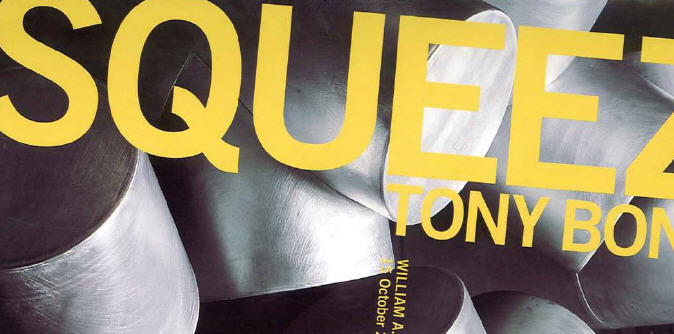This exhibition is now closed
Tony Bond: Squeeze
15 October 2004 –
9 January 2005

Tony Bond ML2 2004. Fibreglass, chrome, plastic rope. Collection of the artist
An exhibition of new work by local artist Tony Bond, using ordinary and often disregarded objects to create large-scale sculptures that are playful and intriguing.
Tony Bond ‘colonises' an exhibition space with ordinary objects transformed into playful and intriguing large-scale sculptures. Curator Felicity Milburn spoke with the artist:
Many of your recent sculptures are constructed from functional objects that other people might have ignored – metal clamps, tin cylinders, curtain rings and cable ties. What is it about these kinds of materials that particularly attracts you?
Things created for specific functions tend to be discarded when that function no longer applies, but there is always so much extra to explore. I guess it's about how you perceive beauty – I've always seen it in things that may be considered banal, even disgusting. Every material has certain parameters, the challenge is to work beyond those and to take a thing where it's not supposed to go.
Your work suggests a strong curiosity – about materials, their functions and where objects ‘begin' and ‘end'. Has this always been part of your approach?
Knowing how things work and why has always been important to me. I'm interested in taking things I know and finding alternative ways to express them, without necessarily trying to find meaning. It's about looking for alternative possibilities and asking ‘why does it have to be seen that way?'. I'm trying to discover something new - even if someone else has already discovered it, I need to find it out for myself. I've always liked sciences and at one stage wanted to do engineering. I suppose I have carried a sense of enquiry into art, without needing to be bogged down in technicalities.
Aside from the practicalities, do you approach working with found objects very differently to making ceramic works?
I don't see a big difference between them. They are all materials, just at a different stage of transformation. With ceramics, you are starting with something more primal and changing it. The only difference with using found objects is that someone else has taken the first steps for you. We often differentiate between natural and artificial objects in order to place value, but at an atomic level they are really just different forms. As humans, we've had such a long association with wood and stone; in five thousand years will we look at plastics in the same way? What we once thought of as unnatural and strange has now become commonplace. The kinds of technologies that are being developed mean that in the future it will be much harder to distinguish between what is ‘natural' and what is ‘man-made' – I'm interested in exploring that ambiguity. I seem to be drawn to materials that are not highly regarded, but which are designated as ‘disposable', with no apparent value or potential.
Many of the works, the human-scale 'Mary Lou' sculpture for example, involve the transformation of objects by changing their scale and ‘purpose'.
Making objects work in a different way enhances your appreciation of how they are made. So much is a mystery to me. You know that something works, but not why. We are surrounded by so many complex devices we don't really have a clue about. Many of these works began when I was thinking about the way that objects that were once common on farms are now obsolete. Since so few people now know what they were for, it is possible to transform them into something else – to give them an aesthetic function. ML2 is an example of how very simple forms can be connected to provide meaning. I wanted to upscale her, but to retain that sense of innocent astonishment. I didn't want to just make a big version without transforming her in some way, so I decided to give her a chrome head. Now, you can't look at her without seeing yourself. The challenge is in taking an object that people have already dismissed and creating something with it that has a sense of mystery.
What kinds of responses are you hoping for from visitors?
In a way, the viewer's experience is the reverse of the artist's – they will see the sculpture I've created and then realise what it is made of. I hope that will encourage them to open their minds to other possibilities. My work isn't about being didactic, it's about testing and proposing things. I want people to see these sculptures and wonder why I made them, to ask what they are ‘for', why would you need a giant Mary Lou doll? Hopefully, the work will cause some sort of intrigue, maybe confusion, but most importantly a sense of wonder.
Exhibition number 727
Curator:
Felicity Milburn
Exhibition number: 727
